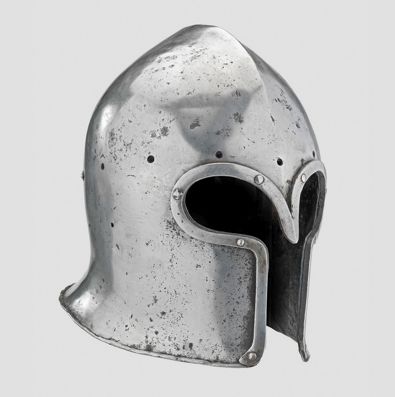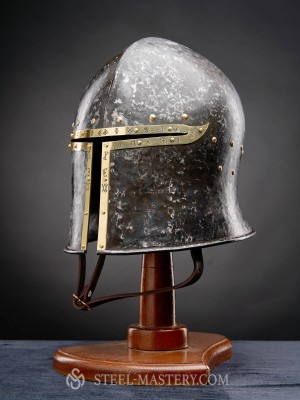About Barbute helmets
Barbute was a kind of Classic Corinthian helmet during Renaissance in the third quarter XVth century. Medieval barbute helmets consciously copied elements of ancient helmets simultaneously being separate narrowly specialized form of salled, which, in turn, evolved from an early bascinet. No wonder that barbute helmet wasn’t that popular outside Italy as it appeared concurrently with much more functional salled. But Romans’ descendants were no strangers to unusual things.
Just as hoplite helmet, barbuta is unique due to its visorless design and distinctive "T" shape or "Y" shape opening for eyes and mouth. Dome’s sides extended towards the front protecting fighter's face below the eyes.
T-shaped opening’s edge in most cases was reinforced with riveted iron rim. At the same time, Y-shaped's edge often had distinct ledge guarding wearer’s nose. Visiting the Metropolitan Museum, you can see interesting exemplar with hinged long nasal.
Historically, barbute was mostly worn with "standard" – stiff mail collar – for the quality throat and neck protection. But it could also be worn with plate gorget or else.
Interestingly, some of discovered barbute helms were covered by rich decorative fabric, mostly – velvet. Moreover, loads of barbute helmets had a hole at skull’s top for attaching decorative crests.
Commonly, barbuta was made from single metal sheet but some could be made of iron faced with steel (hard outer surface with ductile inner layer) to prolong dome's life.
Barbutes were mostly forged with one rib-crest going from the forehead to head’s back, which made it possible to further strengthen head protection without increasing its weight too much.
Our blacksmiths have been working with medieval helmets for over 15 years, so you can just order one to your taste and be sure that you’ll receive a top-quality custom product according to your wishes.
Talking of measurements, don’t forget to use our How to take measurements for helmets manual.
If you haven’t found among our barbute helmets for sale the one you want, contact us via [email protected]. We’ll create a custom model specially for you.
Barbutes with hinged nasals are recorded in Italian paintings and miniatures, but only two helmets with surviving nasals are known, both from Chalcis.
Barbute with Hinged Nasal, ca. 1450, Italy, probably Milan

Barbute, ca. 1475, Bernardino da Carnago, Italy
.jpg)
Barbute, ca. 1470–80, Pietro da Castello, Italy
.jpg)
Barbute, Italy., ca. 1450/70




